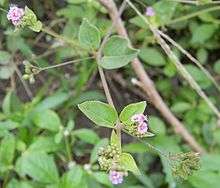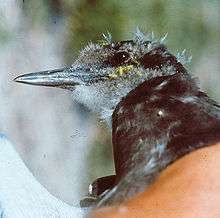Boerhavia diffusa
| Boerhavia diffusa | |
|---|---|
 | |
| Scientific classification | |
| Kingdom: | Plantae |
| (unranked): | Angiosperms |
| (unranked): | Eudicots |
| (unranked): | Core eudicots |
| Order: | Caryophyllales |
| Family: | Nyctaginaceae |
| Genus: | Boerhavia |
| Species: | B. diffusa |
| Binomial name | |
| Boerhavia diffusa L. nom. cons.[1] | |
Boerhavia diffusa is a species of flowering plant in the four o'clock family which is commonly known as punarnava (meaning that which rejuvenates or renews the body in Ayurveda),[2] red spiderling,[1] spreading hogweed,[1] or tarvine.[1] It is taken in herbal medicine for pain relief and other uses. The leaves of B. diffusa are often used as a green vegetable in many parts of India.
Description

Boerhavia diffusa is widely dispersed, occurring throughout India, the Pacific, and southern United States. This wide range is explained by its small fruit, which are very sticky and grow a few inches off the ground, ideally placed to latch on to small migratory birds as they walk by.[3]
Distribution
A true and accurate accounting of the native range of Boerhavia diffusa has not been determined. However, it is very widespread, and has become naturalized in many places. It is believed[1] to be a native plant to the following places:
- Africa —
Botswana; Egypt; Ghana; Kenya; Liberia; Malawi; Mozambique; Namibia; Nigeria; Rwanda; Senegal; Sierra Leone; Somalia; South Africa (Eastern Cape, Gauteng, KwaZulu-Natal, Limpopo, Mpumalanga, Northern Cape provinces); Swaziland; Tanzania; Togo; Uganda; Zambia; and Zimbabwe.
- Asia —
Burma; Cambodia; China (Fujian, Guangdong, Guangxi, Guizhou, Hainan, Sichuan, and Yunnan provinces) India;Bangladesh; Indonesia; Japan (Ryukyu Islands); Laos; Malaysia; Nepal; the Philippines; southern Taiwan; Thailand; and Vietnam. Also, on the Arabian Peninsula: Oman; Saudi Arabia; and the United Arab Emirates; and Yemen (Socotra).
- North America —
Mexico; and the U.S. (in the states of Florida, Georgia, and South Carolina).
- Caribbean —
Anguilla; the Bahamas; the Cayman Islands; Cuba; Dominica; Grenada; Hispaniola (Dominican Republic and Haiti); Jamaica; Montserrat; the Netherlands Antilles (Saba); Puerto Rico; Saint Lucia; Saint Vincent and the Grenadines; and both the British and the U.S. Virgin Islands.
- South America —
Argentina; Belize; Bolivia; Chile; Costa Rica; Ecuador; French Guiana; Guatemala; Guyana; Nicaragua; Panama; Paraguay; Peru; Suriname; Uruguay; and Venezuela.
- South Pacific —
Fiji; and New Caledonia.
Economic importance
B. diffusa is widely used as a green leafy vegetable in many Asian and African countries. B. diffusa can be used as a fodder for livestock, but has the potential for contaminating seed stocks, and may harbor pathogens for certain crops, such as eggplants.[1]
Chemistry
Boeravinones G and H are two rotenoids isolated from B. diffusa.[4] A quinolone alkaloid, lunamarine, isolated from B. diffusa[5] has shown some in vitro anticancer,[6] antiestrogenic,[7] immunomodulatory,[8] and anti-amoebic activity (particularly against Entamoeba histolytica).[9] The plant contains a protein called BDP-30, presumably a ribosome-inactivating protein.[10]
References
- 1 2 3 4 5 6 Boerhavia diffusa was originally described and published in Species Plantarum 1:3. 1753. GRIN (December 21, 2010). "Boerhavia diffusa information from NPGS/GRIN". Taxonomy for Plants. National Germplasm Resources Laboratory, Beltsville, Maryland: USDA, ARS, National Genetic Resources Program. Retrieved March 14, 2013.
nom. cons. … exact native range obscure
- ↑ Bhowmik Debjit; Kumar K. P. Sampath; Srivastava Shweta; Paswan Shravan; Sankar Amit; Dutta Dutta (2012). "Traditional Indian Herbs: Punarnava and Its Medicinal Importance" (PDF). Journal of Pharmacognosy and Phytochemistry. 1 (1): 52–57.
- ↑ Sherwin Carlquist (2008). "Dispersal to Islands". Plant Discorveries : Sherwin Carlquist. Retrieved March 13, 2013.
- ↑ Ahmed-Belkacem, A; MacAlou, S; Borrelli, F; Capasso, R; Fattorusso, E; Taglialatela-Scafati, O; Di Pietro, A (2007). "Nonprenylated rotenoids, a new class of potent breast cancer resistance protein inhibitors". Journal of Medicinal Chemistry. 50 (8): 1933–8. doi:10.1021/jm061450q. PMID 17341062.
- ↑ "Punarnavine". Comparative Toxicogenomics Database. Salisbury Cove, Maine: Mount Desert Island Biological Lab. March 6, 2013. Retrieved March 13, 2013.
- ↑ Manu K.A.; Kuttan G. (2009). "Punarnavine induces apoptosis in B16F-10 melanoma cells by inhibiting NF-kappaB signaling". Asian Pacific Journal of Cancer Prevention. 10 (6): 1031–1037. PMID 20192578.
- ↑ Sreeja S.; Sreeja S. (2009). "An in vitro study on antiproliferative and antiestrogenic effects of Boerhaavia diffusa L. extracts". Journal of Ethnopharmacology. 126 (2): 221–225. doi:10.1016/j.jep.2009.08.041. PMID 19723573.
- ↑ Manu K.A.; Kuttan G. (2009). "Immunomodulatory activities of Punarnavine, an alkaloid from Boerhaavia diffusa". Immunopharmacology and Immunotoxicology. 31 (3): 377–387. doi:10.1080/08923970802702036. PMID 19555203.
- ↑ Sohni YR.; Kaimal P.; Bhatt RM. (Jan 1995). "The antiamoebic effect of a crude drug formulation of herbal extracts against Entamoeba histolytica in vitro and in vivo". Journal of Ethnopharmacology. 45 (1): 43–52. doi:10.1016/0378-8741(94)01194-5.
- ↑ Shalini Srivastava; HN Verma; Aparana Srivastava; Vivek Prasad (2015). "BDP-30, a systemic resistance inducer from Boerhaavia diffusa L., suppresses TMV infection, and displays homology with ribosome-inactivating proteins". Journal of Biosciences. 40 (1): 125–135. doi:10.1007/s12038-014-9494-0.
External links
- Tropical Plant Database
- Boerhavia diffusa on ibiblio
- Caldecott, Todd (2006). Ayurveda: The Divine Science of Life. Elsevier/Mosby. ISBN 0-7234-3410-7. Contains a detailed monograph on Boerhavia diffusa (Punarnava) as well as a discussion of health benefits and usage in clinical practice. Available online at https://web.archive.org/web/20110616192944/http://www.toddcaldecott.com:80/index.php/herbs/learning-herbs/323-punarnava
| Wikimedia Commons has media related to Boerhavia diffusa. |